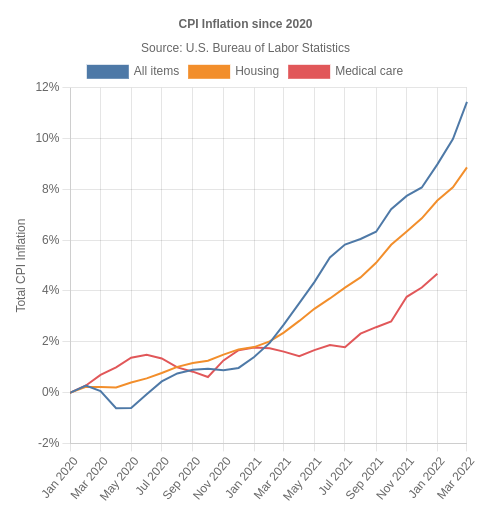Inflation in 1918 and its effect on dollar value
$1 in 1917 is equivalent in purchasing power to about $1.18 in 1918. The dollar had an average inflation rate of 17.97% per year between 1917 and 1918, producing a cumulative price increase of 17.97%. Purchasing power decreased by 17.97% in 1918 compared to 1917. On average, you would have to spend 17.97% more money in 1918 than in 1917 for the same item.
This means that prices in 1918 are 1.18 times as high as average prices since 1917, according to the Bureau of Labor Statistics consumer price index.
The inflation rate in 1917 was 17.43%. The inflation rate in 1918 was 17.97%. The 1918 inflation rate is higher compared to the average inflation rate of 2.89% per year between 1918 and 2025.
Inflation rate is calculated by change in the consumer price index (CPI). The CPI in 1918 was 15.10. It was 12.80 in the previous year, 1917. The difference in CPI between the years is used by the Bureau of Labor Statistics to officially determine inflation.
| Average inflation rate | 17.97% |
| Converted amount $1 base | $1.18 |
| Price difference $1 base | $0.18 |
| CPI in 1917 | 12.800 |
| CPI in 1918 | 15.100 |
| Inflation in 1917 | 17.43% |
| Inflation in 1918 | 17.97% |
| $1 in 1917 | $1.18 in 1918 |
Inflation by City
Inflation can vary widely by city, even within the United States. Here's how some cities fared in 1917 to 1918 (figures shown are purchasing power equivalents of $1):
- Seattle, Washington: 22.53% average rate, $1 → $1.23, cumulative change of 22.53%
- New York: 22.09% average rate, $1 → $1.22, cumulative change of 22.09%
- Detroit, Michigan: 21.89% average rate, $1 → $1.22, cumulative change of 21.89%
- Philadelphia, Pennsylvania: 21.45% average rate, $1 → $1.21, cumulative change of 21.45%
- Houston, Texas: 21.04% average rate, $1 → $1.21, cumulative change of 21.04%
- Boston, Massachusetts: 17.79% average rate, $1 → $1.18, cumulative change of 17.79%
- Chicago, Illinois: 16.80% average rate, $1 → $1.17, cumulative change of 16.80%
- San Francisco, California: 16.53% average rate, $1 → $1.17, cumulative change of 16.53%
Seattle, Washington experienced the highest rate of inflation during the 1 years between 1917 and 1918 (22.53%).
San Francisco, California experienced the lowest rate of inflation during the 1 years between 1917 and 1918 (16.53%).
Note that some locations showing 0% inflation may have not yet reported latest data.
Inflation by Country
Inflation can also vary widely by country. For comparison, in the UK £1.00 in 1917 would be equivalent to £1.22 in 1918, an absolute change of £0.22 and a cumulative change of 22.09%.
In Canada, CA$1.00 in 1917 would be equivalent to CA$1.13 in 1918, an absolute change of CA$0.13 and a cumulative change of 13.11%.
Compare these numbers to the US's overall absolute change of $0.18 and total percent change of 17.97%.
Inflation by Spending Category
CPI is the weighted combination of many categories of spending that are tracked by the government. Breaking down these categories helps explain the main drivers behind price changes.
This chart shows the average rate of inflation for select CPI categories between 1917 and 1918.
Compare these values to the overall average of 17.97% per year:
| Category | Avg Inflation (%) | Total Inflation (%) | $1 in 1917 → 1918 |
|---|---|---|---|
| Food and beverages | 0.00 | 0.00 | 1.00 |
| Housing | 0.00 | 0.00 | 1.00 |
| Apparel | 39.39 | 39.39 | 1.39 |
| Transportation | 0.00 | 0.00 | 1.00 |
| Medical care | 0.00 | 0.00 | 1.00 |
| Recreation | 0.00 | 0.00 | 1.00 |
| Education and communication | 0.00 | 0.00 | 1.00 |
| Other goods and services | 0.00 | 0.00 | 1.00 |
For all these visualizations, it's important to note that not all categories may have been tracked since 1917. This table and charts use the earliest available data for each category.
How to calculate inflation rate for $1, 1917 to 1918
Our calculations use the following inflation rate formula to calculate the change in value between 1917 and 1918:
Then plug in historical CPI values. The U.S. CPI was 12.8 in the year 1917 and 15.1 in 1918:
$1 in 1917 has the same "purchasing power" or "buying power" as $1.18 in 1918.
To get the total inflation rate for the 1 years between 1917 and 1918, we use the following formula:
Plugging in the values to this equation, we get:
Comparison to S&P 500 Index
To help put this inflation into perspective, if we had invested $1 in the S&P 500 index in 1917, our investment would be nominally worth approximately $0.96 in 1918. This is a return on investment of -3.81%, with an absolute return of $-0.04 on top of the original $1.
These numbers are not inflation adjusted, so they are considered nominal. In order to evaluate the real return on our investment, we must calculate the return with inflation taken into account.
The compounding effect of inflation would account for 15.23% of returns ($0.15) during this period. This means the inflation-adjusted real return of our $1 investment is $-0.18. You may also want to account for capital gains tax, which would take your real return down to around $0 for most people.
| Original Amount | Final Amount | Change | |
|---|---|---|---|
| Nominal | $1 | $0.96 | -3.81% |
| Real Inflation Adjusted | $1 | $0.82 | -18.46% |
Information displayed above may differ slightly from other S&P 500 calculators. Minor discrepancies can occur because we use the latest CPI data for inflation, annualized inflation numbers for previous years, and we compute S&P price and dividends from January of 1917 to latest available data for 1918 using average monthly close price.
For more details on the S&P 500 between 1917 and 1918, see the stock market returns calculator.
Data source & citation
Raw data for these calculations comes from the Bureau of Labor Statistics' Consumer Price Index (CPI), established in 1913. Price index data from 1774 to 1912 is sourced from a historical study conducted by political science professor Robert Sahr at Oregon State University and from the American Antiquarian Society. Price index data from 1634 to 1773 is from the American Antiquarian Society, using British pound equivalents.
You may use the following MLA citation for this page: “Inflation Rate in 1918 | Inflation Calculator.” Official Inflation Data, Alioth Finance, 1 Apr. 2025, https://www.officialdata.org/inflation-rate-in-1918.
Special thanks to QuickChart for their chart image API, which is used for chart downloads.
in2013dollars.com is a reference website maintained by the Official Data Foundation.
| Average inflation rate | 17.97% |
| Converted amount $1 base | $1.18 |
| Price difference $1 base | $0.18 |
| CPI in 1917 | 12.800 |
| CPI in 1918 | 15.100 |
| Inflation in 1917 | 17.43% |
| Inflation in 1918 | 17.97% |
| $1 in 1917 | $1.18 in 1918 |

